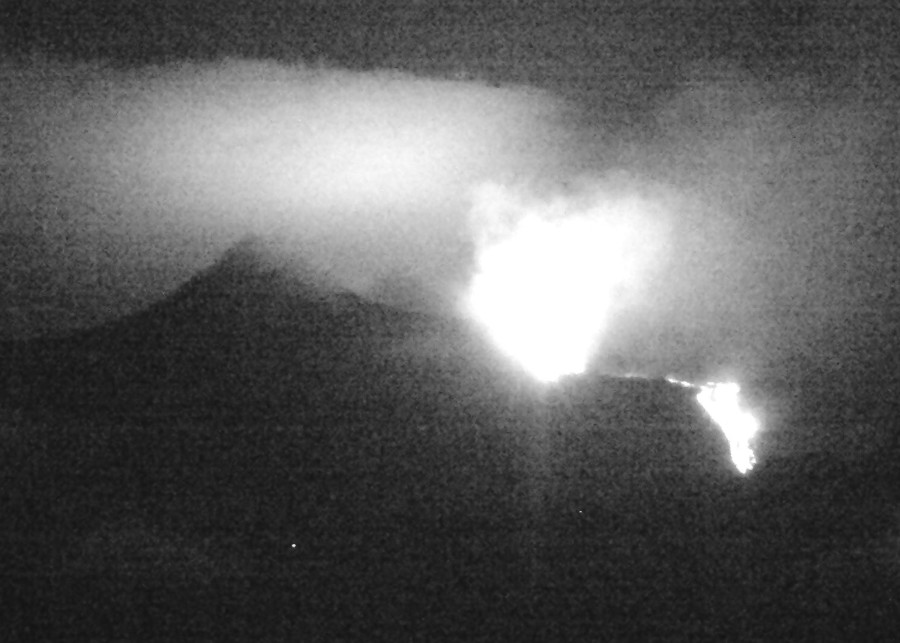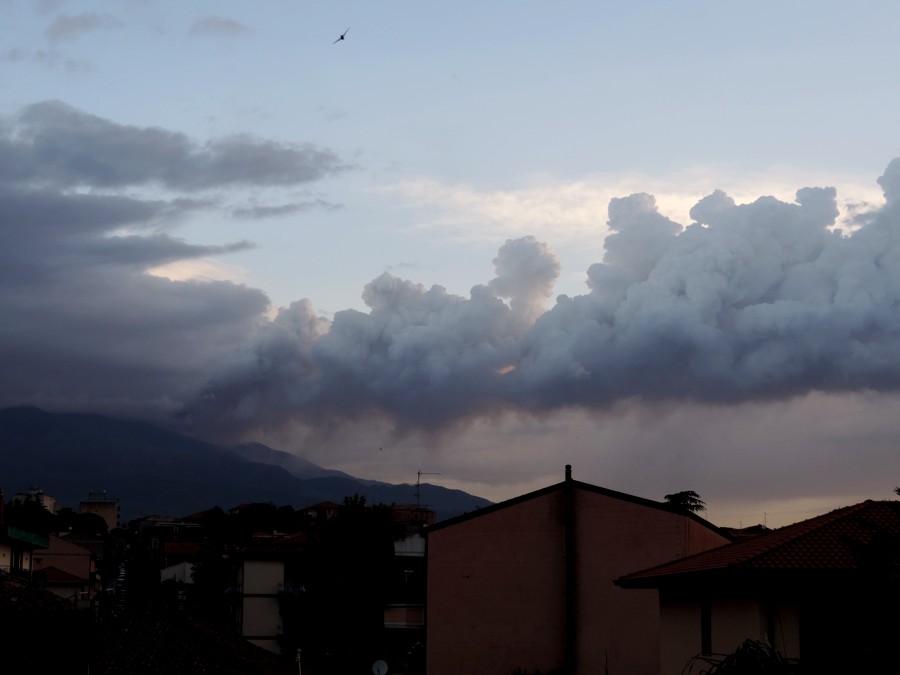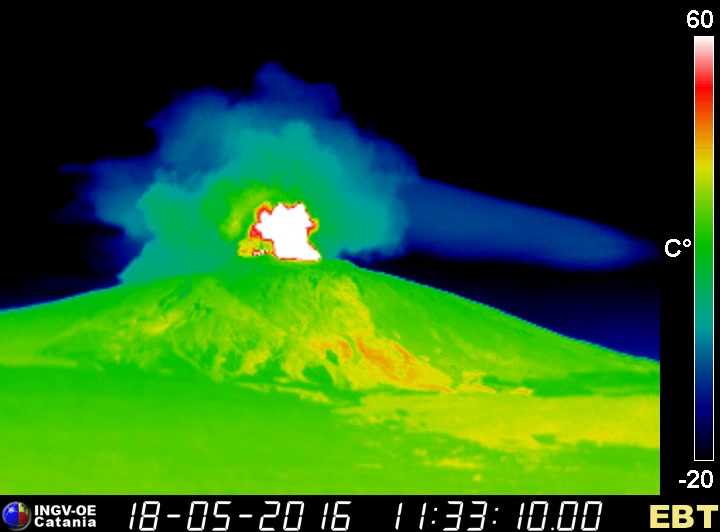
Nel pomeriggio di ieri, 18 maggio, l'attività di fontana di lava al cratere Voragine (VOR) dell'Etna è passata a una modesta attività stromboliana, che ha continuato ad alimentare il trabocco lavico verso ovest fino alla tarda serata (vedi prima immagine a sinistra, ripresa dalla telecamera termica a Bronte EBT). Una seconda colata di lava, alimentata da una bocca effusiva posta vicino al più basso dei due conetti formatisi durante l'attività subterminale di luglio-agosto 2014, alla base del cono del Cratere di Nord-Est (NEC), si è riversata verso la parte settentrionale della Valle del Bove in direzione di Monte Simone. Questa colata è rimasta attiva fino alle prime ore di oggi, 19 maggio (vedi seconda immagine a sinistra, ripresa dalla telecamera ad alta definizione a Monte Cagliato EMCH), anche se, dopo la mezzanotte, il fronte più avanzato non sembrava più alimentato. Poco prima di mezzanotte si è osservato un modesto aumento del tremore vulcanico e il clinometro, installato a Punta Lucia a circa 1 km a nord-ovest del NEC, ha nuovamente registrato un rigonfiamento dell'area sommitale.

Nel mattino, l'ampiezza del tremore vulcanico ha mostrato un repentino aumento e, contemporaneamente, si sono uditi boati forti e quasi continui nei centri abitati nei settori orientale e meridionale del vulcano. Si è formata una densa nube eruttiva, spinta dal fortissimo vento verso est, che ha raggiunto un'altezza di poco più di 1 km sopra la cima dell'Etna (vedi terza immagine a sinistra, ripresa da Tremestieri Etneo, sul fianco meridionale del vulcano). Ricadute di cenere e lapilli sono avvenute sul fianco orientale, in una zona immediatamente a nord di quella interessata dalle ricadute piroclastiche del giorno precedente. L'osservazione del fenomeno è stata resa difficile a causa delle cattive condizioni meteorologiche; tuttavia i dati strumentali - localizzazione delle sorgenti del tremore vulcanico e dei segnali infrasonici – hanno rilevato un nuovo episodio parossistico alla VOR, confermato alcune ore dopo quando le immagini, trasmesse dalla telecamera termica EBT (Bronte), hanno mostrato un nuovo trabocco verso ovest, con una colata di lava che si sovrapponeva a quella della sera precedente. L'attività eruttiva è continuata fino alle ore 09:00 locali, quando si è osservata una rapida diminuzione dell'ampiezza del tremore vulcanico. All'ora della pubblicazione di questo aggiornamento, le cattive condizioni meteorologiche impediscono fortemente l'osservazione dell'attività eruttiva.

L'attività eruttiva viene seguita costantemente attraverso i sistemi di sorveglianza visiva, termica, sismica, infrasonica e delle deformazioni del suolo.
ETNA UPDATE, 19 MAY 2016, 11:00 UTC
During the afternoon of 18 May 2016, the lava fountaining activity from Etna's Voragine crater passed into a modest Strombolian activity, which continued to feed the lava overflow toward west until the late evening (see first image at left, recorded by the thermal camera at Bronte, EBT). A second lava flow, which was emitted from an effusive vent located near the lower of the two conelets formed during the subterminal activity of July-August 2014, at the eastern base of the Northeast Crater (NEC), expanded into the northern portion of the Valle del Bove in the direction of Monte Simone. This lava flow remained active until the early morning hours of today, 19 May 2016 (see second image at left, recorded by the high-definition camera at Monte Cagliato, EMCH), though its most advanced front seemed to be stagnating after midnight. Shortly before midnight, there was a new increase in the volcanic tremor amplitude, and the clinometer installed at Punta Lucia, about 1 km northwest of the NEC, recorded renewed inflation of the summit area of the volcano.
In the morning, the volcanic tremor amplitude showed a sharp increase, and contemporaneously loud and virtually continuous bangs were heard in populated areas to the east and south of the volcano. A dense eruption cloud was blown by the strong wind toward east at an altitude of little more than 1 km above the summit of Etna (see the third image at left, photographed from the village of Tremesteri Etneo, on Etna's south flank). Ash and lapilli fell onto the east flank of the volcano, in an narrow sector immediately adjacent to the north to area affected by the tephra fall on the previous day. Observation of the activity was difficult due to rather poor weather conditions; instrumental data - mainly the location of the volcanic tremor source and the origin of the infrasonic signals - indicate that a new paroxysmal episode was underway at the VOR. This was confirmed a few hours later when the images transmitted by the termal monitoring camera EBT (Bronte) revealed a new lava overflow toward west, feeding a lava flow that descended on top of the lava of the previous evening. Eruptive activity was continuing at 09:00 local time, though the volcanic tremor amplitude was diminishing. At the time this update goes online, the inclement weather conditions are preventing observation of the activity going on at Etna's summit.
The eruptive activity is monitored continuously by the systems of video and thermal cameras, seismic stations and ground deformation




